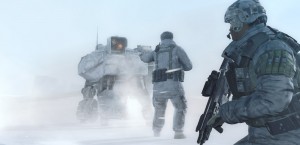Review - Ghost Recon: Future Soldier
Language »
Sometimes the little details can tell us a lot about a game. Think about Call of Duty; the way you can skip through all the splash screens and make it into a game within seconds. If you read into metaphor, it suggests a slick, streamlined experience based around instant gratification (which is pretty accurate, no?) Or maybe Battlefield 3. On the 360 version at least, the single player game was relegated to the second game disc, implying a lot about its quality and the publisher’s confidence in it.
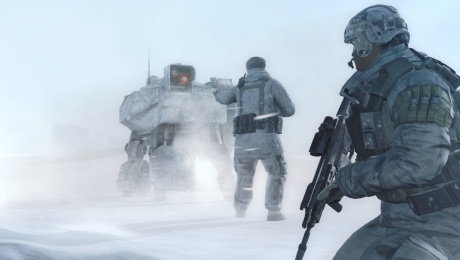
So you can imagine what I thought when I booted up Ghost Recon: Future Soldier, saw a splash screen with three distinct dev studios and then a menu which listed multiplayer above the campaign. Let’s just say, my hopes were not high for the single player game. I knew that Ubi’s Red Storm studio was once again handling the multiplayer and, having played the beta, I knew that with a few tweaks it could be very, very good.
However, I also knew that the single player had caused a few problems for Ubi, with the project undergoing re-evaluation after a subdued response to its E3 demo in 2010. With two dev teams – Ubi’s Paris and Bucharest studios – sharing the helm, the fear was that the campaign could be a disjointed, inconsistent affair. And, undoubtedly, it does have that feel in places. But, to be fair to Ubi, for the most part it’s a solid, fast-paced single player game. Albeit one that feels very different to its predecessors. And pretty damn similar to the competition.
Future Soldier tells the story of - you guessed it - the Western world under attack by very clever terrorists. Following a particularly unsuccessful mission in Nicaragua, in which an entire Ghost team is wiped out, Hunter team is called in to pick up the pieces and follow the trail of informants, goodies, baddies, weapons and elite Russian bad-asses across the planet. You take on the role of Hunter team’s Kozak, not that you’d know it as he’s so lacking in character that I honestly thought I was just playing “nameless new recruit #5098” until about 6 hours in to the game. Characterisation, you could argue, is not Future Soldier’s strong point.
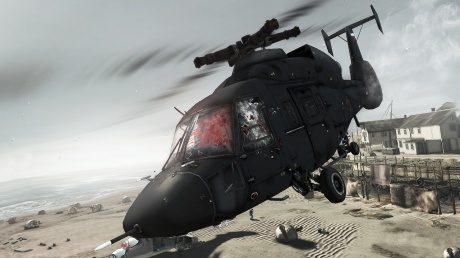
Indeed, if gruff black squad leader and wisecracking redneck sound a bit familiar, that’s because we’ve seen them more than a few times before. In fact, Future Soldier tours just about every shooter cliché of the past five years, from rogue Russian baddies to slow-motion breaching to on-rails, nick-of-time turret sections. It even sports a cutscene of a terrorist attack captured on camcorder by tourists. Which seems awfully familiar…
Yes Ubisoft, it would seem, wants to get in on the Call of Duty business, hence the globetrotting Michael Bay-isms of the plot and the streamlined, faster-paced gameplay. GRAW purists may scoff at the lack of squad control, and perhaps the OTT set pieces, in Future Soldier, but it seems like a harsh criticism considering how, with the GRAW games, Ubisoft had already diluted the classic PC Ghost Recon tactical formula. In fact, in providing a smoother, quicker experience in Future Soldier, Ubi has crafted a game that not only plays better, but is frequently just as tactical as its predecessors.
The main improvement is in its cover system. GRAW’s slow, clunky, cover dynamics have been replaced with something much more impressive. Snapping to and from cover feels brilliantly responsive but it’s in moving between cover that you realise just how well it works. Like in the Gears of War games, holding down X allows you to shaky-cam sprint and, when in cover, an arrow appears next to potential cover swap locations. Simply hold X to sprint to the next location and snap straight to cover. It’s a simple, elegant system and one which you’ll need to utilise frequently in order to advance.
When combined with the new adaptive camouflage system, you can effectively stealth your way from cover to cover, taking down enemies with suppressed weapons or even up close and personal with silent melee kills. The stealth aspect of Future Soldier is both impressively cool and frequently infuriating, however. In many of the game’s missions, success will be dependent upon remaining undetected, at least for a significant portion of the stage. In these moments, being spotted leads immediately to a mission fail and a checkpoint reload which, while understandable (they are called the ‘Ghosts’ after all), can get pretty frustrating.
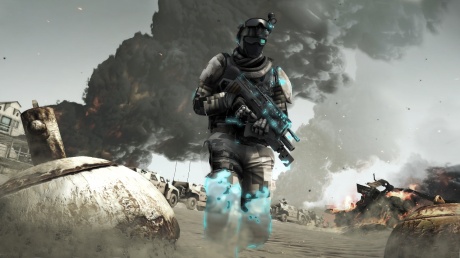
Ubi attempts to mitigate this by providing you with another new feature, the synchronised shot. You can select up to four targets for yourself and your team-mates, wait for them to line up their shots and then give the order to fire. And, to be fair to Ubi, co-ordinating silent attacks with your team-mates never gets old. However, things get a lot more difficult when you’re faced with over six hostiles, only four shots and a mission fail state if a body is found. This is when you’ll need to use the impressive UAV recon drone to full effect, spotting enemies and co-ordinating attacks when they are isolated. It adds a welcome tactical element to the gameplay, undoubtedly, but on occasions you find yourself wondering exactly how the remaining enemies have spotted a dead body through the solid brick wall they’re crouching behind.
Indeed, Future Soldier is at its best when the game simply gives you the option of stealth and being discovered doesn’t mean an insta-fail. These missions work brilliantly, especially in four player co-op as your team sneaks carefully around a level until you accidentally raise the alarm and all hell breaks loose. While the campaign’s story and structure may have a Call of Duty feel about it, its gameplay has considerably more depth thanks to the stealth/recon focus and the co-op function.
However, one thing Future Soldier lacks is the polish of Activision’s cash cow. Perhaps a result of multi-studio development, perhaps a result of squeezing a few more frames-per-second out of the engine, but the visuals and presentation of the PS3 version leave a lot to be desired. In the early levels especially, it was hard not to notice some very muddy textures sitting alongside otherwise smart visuals. Things improve as the game progresses (or maybe my expectations had just been lowered) but there is still a lot of clunky design on show. Cutscenes, for example, may be adequately voiced but look absolutely terrible and sport some of the strangest-looking character models I’ve seen in a long time.
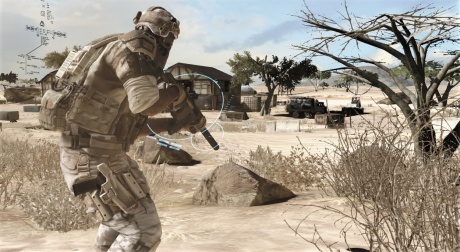
The most irritating problem unfortunately arose during the last level. A level which, without giving too much away, is an upbeat, frenetic pursuit of some serious bad guys. Or, at least, it was meant to be. Because, inexplicably, aiming at enemies became all but impossible thanks to a frankly criminal framerate drop when aiming down the sights. After I miraculously fluked my way through to the game’s conclusion, I was greeted by a terrible final cutscene and jerky rolling credits. I think it’s fair to say that, if you can’t even achieve a smooth framerate in the game credits, you need to spend a little more time on your game.
Nevertheless, while the Paris and Bucharest studios may have dropped the ball in a few areas, Red Storm has done a great job with the multiplayer. The game’s co-op horde-a-like, Guerrilla, offers a few new ideas – like the stealth phase of each wave, allowing for some devious co-operative tactics – but fatigue sets in fairly quickly due to a lack of variety and seemingly only a couple of ‘headquarters’ to defend on each map.
The competitive multiplayer fares much better. If you’ve read our beta preview, you’ll know that we were hugely impressed by the cover system, the focus on teamwork and the depth of the progression/customisation features. These are no less impressive in the final release and Red Storm has even added a brilliant new game mode in the form of Decoy. The teams are provided with three objectives to complete at once, but only one is genuine (the ‘Key’) and two are decoys. Once the Key objective is complete, the final objective will be revealed to the attackers and the defenders must prevent them from completing it.
Alongside the excellent Conflict mode, Decoy is a welcome addition and the developer deserves credit for avoiding the usual TDM and CTF tropes we see all too often. Red Storm has also addressed concerns that were raised in response to the beta. Spawn-killing is now less of a problem thanks to an alternative spawn that appears when your team is pushed right back and, mercifully, grenade damage has been toned down. One remaining criticism is that there is still a lack of visual appeal in the multiplayer maps and the locations, and layouts, feel prosaic.
However, the multiplayer is likely where Future Soldier’s lasting appeal will lie – once the single player has been completed, you’re unlikely to return to it unless accompanied by some co-op partners. Luckily Red Storm has managed to craft a compelling, tactical multiplayer with real depth. If it can continue to support it through quality DLC, there’s a chance its online player count will remain high.



